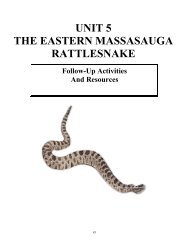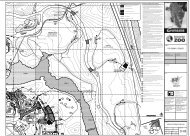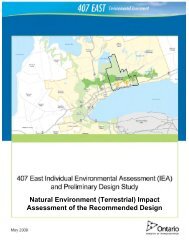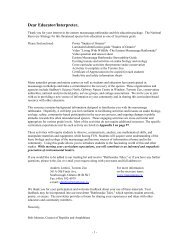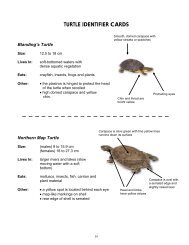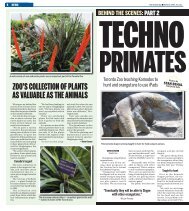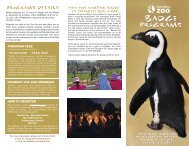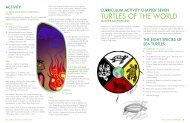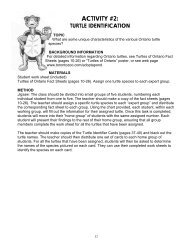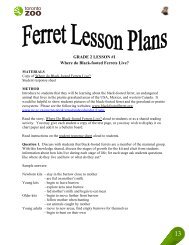Wetland Ecology Concerns Of Today - Toronto Zoo
Wetland Ecology Concerns Of Today - Toronto Zoo
Wetland Ecology Concerns Of Today - Toronto Zoo
Create successful ePaper yourself
Turn your PDF publications into a flip-book with our unique Google optimized e-Paper software.
Snakes Need Shelter Too!<br />
Rava Lee, Snake Biologist, Adopt-A-Pond<br />
In urban Ontario, there's not much room to<br />
grow. That’s especially true for our struggling<br />
snake populations. As development brings<br />
them in closer contact with humans, many are<br />
suffering from misinformed persecution and<br />
habitat fragmentation.<br />
Ontario is extremely lucky to have seventeen<br />
fascinating species of snakes. They come in an<br />
array of sizes, colours and patterns, and they<br />
all share the same shy and mellow<br />
temperament. Snakes are essential in local<br />
ecology; they balance pest populations like<br />
rodents and insects and are a food source for<br />
other predators.<br />
By providing appropriate habitat on your<br />
property you're helping to compensate for the<br />
loss of habitat that has devastated snake<br />
populations for over 100 years. Be sure to read<br />
up on which snakes live in your area to learn<br />
what habitat is most suitable for the species<br />
you’re interested in attracting.<br />
Some snakes like the Blue Racer and Queen<br />
snake only live in one isolated region in<br />
Ontario, and are rarely found in more<br />
urbanized areas. If you have a lake or stream<br />
on your property you're probably already<br />
attracting Northern Water snakes. Adding a<br />
buffer of cattails and marsh plants, however,<br />
can provide preferred habitat for snakes like<br />
the Eastern Ribbon snake, Eastern Fox snake<br />
and Black Rat snake, who like to supplement<br />
their diet of rodents with frogs. If you live in a<br />
region with Black Rat snakes, try looking up in<br />
the trees. These snakes are excellent climbers<br />
and often climb trees in search of birds or<br />
eggs.<br />
One of the most effective ways to attract<br />
snakes is to keep your grass long. Snakes hide<br />
and hunt in taller grass; mowed lawns do not<br />
afford snakes protection from predators and<br />
they also provide no prey. Starting a stone<br />
garden or adding rocky outcrops will also<br />
attract snakes for basking and protection.<br />
Snakes like to hide under wooden boards, in<br />
leaf litter and debris, and in barns and older<br />
buildings with stone foundations.<br />
Photo: Mandy Karch<br />
Milksnake (Lampropeltis triangulum)<br />
If you find a snake, remember not to pick it up<br />
or harass it. Snakes are wild animals and may<br />
inadvertently be injured by inexperienced<br />
hands. They will also defend themselves if they<br />
feel cornered. Snakes always prefer to flee<br />
rather than bite, but will bite if they feel<br />
threatened, so make sure to give your new<br />
friends space and respect.<br />
What we are doing:<br />
One species the <strong>Toronto</strong> <strong>Zoo</strong> and Rouge<br />
Park are especially concerned with is the<br />
Eastern Milksnake. A species with bright<br />
iridescent scales, large eyes and a<br />
flickering pink tongue, these snakes have<br />
been the victim of increasing road<br />
casualties. In addition, because of their<br />
patterning they are often mistaken for the<br />
Massasauga Rattlesnake, though the<br />
Massasauga is only found in a few<br />
isolated populations throughout Ontario.<br />
Milksnakes are not poisonous and are shy<br />
by nature, active mostly during dawn and<br />
dusk. In 2011, the Adopt-a-Pond<br />
Programme initiated a Milksnake survey<br />
project in Rouge Park in response to a<br />
number of snakes sighted dead on roads.<br />
The project will continue in 2012, and will<br />
help to understand Milksnake distribution<br />
and movement patterns in the Park.<br />
6



